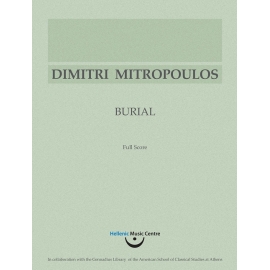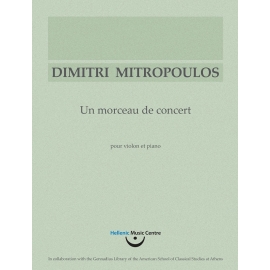No products
Product successfully added to your shopping cart
There are 0 items in your cart. There is 1 item in your cart.
 View larger
View larger
Online only
Mitropoulos: Burial
HMC 005r
New
Dimitri Mitropoulos (1896-1960)
Burial (1915)
Orchestral parts available on hire
Published in collaboration with the Gennadius Library
Instrumentation: 2, 3 (3.=Ε.Η.), 2, 2 – 4, 2, 3, 1 – Timp., 3 Perc. – Hrp. – Strings
Duration: 9’
Score designing and editing: Yannis Tselikas
Music Copying:Nikolas Voyadzis
Foreword: Haris Xanthoudakis
Translations: Helena Grigorea, Giorgos Vakalopoulos
Graphic design: Antonis Kapiris
Details
| Composer | Mitropoulos, Dimitri |
More info
Foreword
According to a note in French added to the only manuscript score of Tafí (Burial), kept in the Mitropoulos Archives of the Gennadius Library in Athens, this orchestral work was completed on Thursday 9 (New Style 22) April 1915, when nineteen-year-old Dimitri Mitropoulos (1896-1960) was studying at the Athens Conservatory on a scholarship under Ludwig Wassenhoven (piano) andArmand Marsick (counterpoint). During the last three or four years, he had already shown signs of creativity – some pieces for piano, for violin and piano, for voice and piano, as well as a short work for string quartet (Danse des faunes) – but this was the first time that he embarked on a large-scale work for orchestra. As it turned out, the great conductor was to use the symphonic medium on very few occasions in his own compositions: in the Concerto Grosso(1928), in his opera Sœur Béatrice (1918-1920), in the incidental music to two Greek tragedies (Sophocles’ Electra, 1936, and Euripides’ Hippolytus, 1937) and some orchestrations of works by Bach and Saint-Saëns.
On the title page of the manuscript, Mitropoulos quotes the laconic description of the burial of Jesus by Joseph from St. Matthew’s gospel. He then goes on to inform us, in an equally laconic manner, that this work is a lament ‘for him that suffered for us, for him that everyone must love and worship’. The inherent pietism of this programmatic declaration is revealed in its true dimensions and significance through the French poetical extracts cited in the inner page of the score: they are two extracts from the third part (‘Christ on the Cross’) of the second book of Victor Hugo’s unfinished poem La fin de Satan (‘The End of Satan’), one of his later verse works. In that extensive Biblical epic, interspersed with Cabbalistic and Talmudic motifs, the poet describes the tribulations of humanity caused by the three deadly weapons with which Lilith, fallen Satan’s apostle, armed Cain’s hand: the bronze weapon (symbol of the sword), the wooden weapon (standing for the cross and the gallows) and the stone weapon (representing prison, the emblem of human captivity and bondage). In the two excerpts that Mitropoulos uses as a literary inspiration for his symphonic lament, the Crucifixion does not bring redemption, and Calvary remains the eternal scene of crime, the place ‘where religion killed God’.
The part that summarizes Hugo’s basic idea that ‘the chain of evil, murder and war’ was broken by the sacrifice of ‘Christ the liberator’ but was forged again through the dogma of his own teaching was not chosen by Mitropoulos. However, the excerpt – and especially its concluding phrase – leaves no doubt as to the philosophical attitude of the composer of the Burial and the central concept of this musical threnody. Mitropoulos attempts to interpret musically the stentorian denouncing tones of the great French Romantic at a point in time when the nationalistic war cries of a massacre unprecedented in history stifled every individual pacifist voice. He thus prefigures the young member of the most progressive circles in Berlin, the metropolis of rising Nazism, or, in later life, the champion of the universal musical cause, who supported the doomed campaign of socialist-oriented presidential candidate Henry Wallace at the dawn of the McCarthy era.
The Burial faithfully follows the model of ‘school fugue’ as described in Gédalge’s French manual – the fugue student’s bible in pre- and post-war Greece. The successive expositions, with diminutions of the theme in between, the repeated stretti, with increasingly thickening entries, the inversions of the theme, the two successive pédales of the ending (on the dominant and the tonic respectively), as well as the numerous episodes of varying length, by no means constitute proof of compositional originality nor are they elements of personal expression but ingredients of the typical academic model. On the contrary, the fact that young Mitropoulos manages to breathe life into such a rigid and complex form and create musical emotion while remaining faithful to the details of the academic type must be considered an achievement. His somewhat limited formal initiative leaves room perhaps for a possible attempt at a more personal interpretation: the first exposition, for instance, which replaces the traditional tonic pattern of thematic entry (1st-5th-1st-5th) with one less common (1st-5th-3rd-8th), might remind one that the four-part cyclical completion (1-3-5-8) of the three-part chord (1-3-5) has occasionally been used in the past as a symbol of the Cross.
There is, however, a particular aspect of this work that cannot escape notice and deserves some comment. In the alternation or the mixing of the diatonic writing required by the theme of the fugue (natural Aeolian mode) and the chromaticism that results from the chromatic counter-themes or the episodes, stands out an intermediate version of the theme, with a sharpened 7th degree (leading-tone), which displays the interval of augmented 2nd, very popular among the composers of the ‘Greek National School’. This interval recurs throughout the oeuvre of Mitropoulos, though it never constituted a structural element of the successive musical idioms that he adopted. Yet it is a symbolic feature characteristic of the composer. Thus, for example, his two settings of the Latin hymn ‘Ave Maris Stella’ in the opera Sœur Béatrice (one without, the other with an interval of augmented 2nd) symbolize the heavenly and earthly presence respectively of the Blessed Virgin in the plot, while in the Greek Sonata for piano the same interval functions as a formational thematic feature, within a generalized ‘neutral’ chromatic mode of writing, and at the same time as an element of a symbolic ‘Greek quality’. How could the same interval function in the Burial? More, perhaps, than an allusion to Eastern Church music scales (the initial Aeolian mode of the theme fulfils this role), it is probably used as a symbol of the popular religious culture, a reminder of the pagan background of Greek Easter, an emblem of the direct, instinctive interaction of the common man with Christ on the Cross, who was betrayed by those in power and their minions.
Dimitri Mitropoulos’ Burial was premiered at the Sixth Concert (the last of the year) of the Subscribers to the Athens Conservatory Orchestra, on 29 April 1915 (Old Style), under the baton of the young composer.
HARIS XANTHOUDAKIS
English translation by Helena Grigorea
Accessories
6 other products in the same category:











